|
Bill Powelson's,
MUSICAL TIME & RHYTHMS:
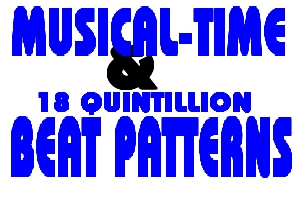
"FINITE TO INFINITY"
Understanding Time-Signatures

Almost any music instruction manual will teach the basics of time-signatures. The objective here is to
take you far beyond all the basics. Struggle through this lesson, even if it exhausts you mentally.
This could be the most valuable music lesson you will ever take. I do not think you will argue
against that point if you make it to the bombshell at the end.
What is a time-signature?
A time-signature is fractional looking number, a formula that determines the count in
a piece of music. A time-signature formula should always precede any written notation and
may often be used more than once in a song to show any changes in the counting procedure.
Think of a time-signature as a code telling you how to count and feel a particular rhythm.
Let us break that code to reveal its secrets, in this way:
4/4 is a common time-signature
The top number = 4 = tells how many counts = (Could be any number.)
The bottom number = 4 = what kind = (must represent a note-value.)
What does this mean?
Our top number here is four. This means that each measure will have four counts. The top
number can be any number within reason. Anything more than 64 is considered quite unreasonable.
The bottom number here is also four, indicating quarter notes. This means that each following
measure must equal four/quarter notes.
The bottom number must represent a note value. We may figure out note value representations from
the following chart:
Notice: A form of triplets will exist between each of the note values below. We will not be
concerned with those triplets in this stage of the time-signature system. However; the importance
of triplets will be obvious a little later when we study the dance beat forms of each time-signature.
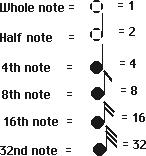
How many different time-signature formulas are there?
The top number can be any reasonable number (1 to an arbitrary 32 or 64.) The bottom numbers may be
any of the following 1, 2, 4, 8, 16, 32, 64 and so on. No specific limit on the number of formulas has
been set as far as I know. To keep everything within reason we will use 32 as an arbitrary
stop point. If you understand that much, you will be ready to take on the big guys. So, to state it
arbitrarily, you may have time-signatures running from 1/1 through 32/1 all the way through the note
value system (bottom numbers 1, 2, 4, 8, 16, 32). The last time-signature in this line of thought
would be 32/32. Before anyone goes into a complete state of shock, let me say that many of these
strange signature formulas are rarely used. About the only logical use for a time-signature like
1/4 or 1/8 might be to write a one count exercise in a music method book. Also, many beat replications
appear within the system. For drummers this means that we often see the same beat patterns with different
time-signature formulas. The notation and time-signature formula may look different but the beat will
often be one with which we are very familiar. For example, check out the waltz beat lesson again. Notice
that triplet 3/4 and 9/8 are actually the exact same basic dance beat.
The rest of the story . . .
Most music instruction books drop you off around this point, leaving you to figure out the rest. It
is safer that way! The system is immensely complex. I am going to try to take it a lot further, but
I may show my own ignorance a time or two before I achieve perfection. Bear with me! I am just trying
to simplify a very deep and complex subject.
I have compiled most of the following information over many years, teaching, playing, dabbling
with computer programming and drum machines. The teaching methods in the later half of this lesson
are my own. I am using some explosive ideas in regards to describing rhythms and musical time, from
the pop-music, and drummers perspective. All this relates to the pop music styles we know and love today.
If you know of any other book that uses these same ideas, please E-mail
the details (Title, author and publisher) to me, so that I may obtain a copy. I will be forever
grateful. Otherwise, I'll boldly state that you won't find very much of the following information,
anywhere but right here.
Time-signatures into pop-music, dancebeats
What does all that mean to a drummer or modern musician?
Sure, we can talk about 15/8 and know that it contains fifteen eighth note counts to the bar.
However, most of us want to know how to play it, and recognize the many forms of it, within the music we hear
every day. We may want to write songs within that framework!
How do we play the many forms of 5/4, 7/4 and all the others?
You will be happy to learn that it is not as difficult as you might think. A structure
is at work here. It is a very ordered system and if we understand that system, everything
will just fall into place. Hopefully it will hit in a blinding flash within the next few paragraphs.
The other good news is that you already know the hardest part, if you have already followed the
previous lessons within this mini-course.
Time-signatures, Note Values and Dance Beat Structures:
We will begin with something we already know, then build on it. Think about the 4/4 time-signature. We learned in the 'Basic Dance Beats' lesson that 4/4 is made up of many dance beat patterns. Each dance beat pattern, gets its name from the type of note being used on the cymbal line.
Notice: I originally taught these beats in reverse order while illustrating (slow to fast) tempo relationships
to beginners.
Now we should structure our basic dance beats this way:
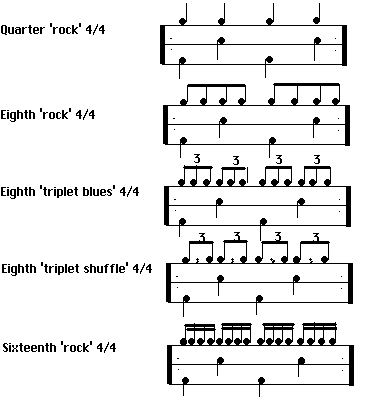
Analyze the 'note value' pattern. Can you see how we structure the basic dance beats in 4/4 time from
quarter notes through sixteenths? The basic dance beat system continues through 64th notes and beyond. We ignored
those beats intentionally because of their infrequent use.
The whole system works on this principle!
Use your head and try to visualize the entire system again, one signature formula at a time. Now, reduce each time-signature into a hierarchy of dance beat patterns. Don't panic! I will help! Think about 3/4 and the system of dance beat patterns that exist there. You will see the same note value structure repeatedly with every new time-signature.
Remember the Waltz beat lesson?
Look at the note value structure; It is the same!. Disregard the 9/8 dance beat in that lesson. 9/8 belongs in the eighth family of signatures and that is another discussion.
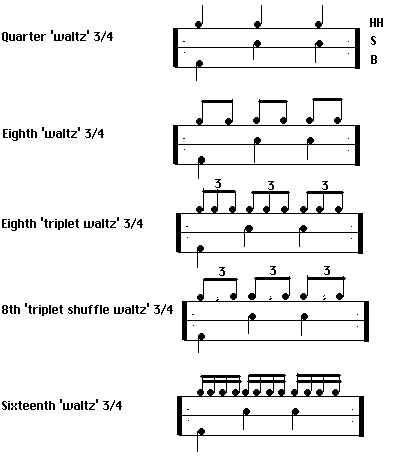
The Blinding Flash!
You should see the whole picture now. What comes after 4/4? The answer is 5/4. Can you visualize that dance beat structure? Try writing a few of those patterns. 5/4 is really 3/4 and 2/4 mixed and it does not matter which comes first (see ‘Quarter note 5/4 . . . below). I will help a little by furnishing the first . . . (Quarter note 5/4) and the last . . . (Sixteenth 5/4). You will need to grab a pencil and piece of paper then figure out the beat patterns that fall in the middle. As you are doing this, the entire pattern should unfold.

HINT: You will write the following:
- Eighth 5/4
- Eighth 'triplet' 5/4
- Eighth 'triplet shuffle' 5/4 (Do not forget the rests.)
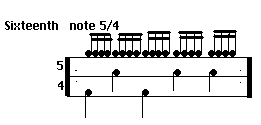
While you are at it, why not examine the following:
- Sixteenth 'triplet' 5/4
- Thirty-second 5/4
- Thirty-second 'triplet' 5/4
- Sixty-fourth 5/4
These later beats are not extremely popular at this time. Who can speak for the future? Imagine
a smoking bass guitar riff and screaming guitar ride as you play these patterns. Add a few lyrics,
dye your hair purple, put a bone through your nose, and you will be ready for the big time!
What is next?
You can figure out the rest on your own. The next signature to study is 6/4. This is an 'even' signature that contains all the same rhythms as 2/4 and 4/4. 6/4 IS those two combined.
NOTE:
If the top number is even (8/4, 10/4, 12/4,etc.), you will usually be dealing with beat patterns that feel natural.
If the top number is 'odd' (7/4, 9/4, 11/4, etc.) then the dance beats will have an unsettling lopsided feel like 5/4.
The Big Bombshell!
Did you study the permutations' lesson? Did you totally understand it? We only investigated one basic beat form of 4/4 in that lesson (Eighth 'rock' 4/4.) Do you remember how we discovered 65536 simple variations and over 4.97 billion complex versions of that beat? Can you see how that theory applies to each basic dance beat in 4/4 and ALL the remaining time-signature formulas? You should buy two or three pencils, you are going to need them.
The 'TRI' chart.
In the permutation lesson we used a chart that we called the 'Quad' Chart. To investigate all the beat variation possibilities in the time-signature system we will need a couple more charts. The most important additional chart is the 'TRI' chart that will help us investigate the permutation possibilities with triplet-based rhythms.
'TRI' CHART
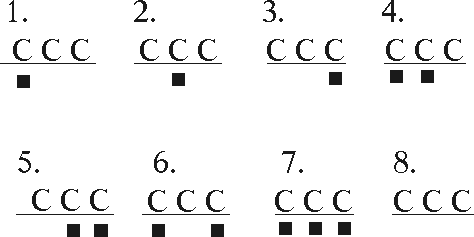
There may also be a need for another chart that is based on two cymbal notes. Of course we would call this a 'BI' chart.
'BI' CHART

These charts have the effect of illustrating and labeling every dance beat in the time-signature system. With this concept, each dance beat has its very own name.
The remaining time-signature families?
The remaining time-signature forms are based on similar logic. You can probably figure it out on your
own from here anyway. 3/8 is really a 'waltz' with weird notation. The beats we have found in
the quarter-note family of signatures (X/4) will exist again in all the remaining (X/1, X/2, X/8, etc.)
time-signature families. This
will include:
- Whole-note (1/1 to 32/1)
- Half-note (1/2 through 32/2)
- Eighth (1/8 through 32/8)
- Sixteenth (1/16 through 32/16)
- . . . and so on.
The notation and signature formulas will be different in each case, but the underlying beats and permutations will
always be the same . . . if we are comparing apples to apples. All the X/X signatures but X/4 are totally unnecessary,
as I'll explain in the next lesson.
PERMUTATION CALCULATOR:
Now it's time to click on the PERMUTATION CALCULATOR , and play around with it
a little. Enter a number between 1 and 32 at the prompt. The Calculator
will then compute the number of permutations within that specific beat framework,
then tell you some of the potential time-signature formulas that might be used to
write those permutations. At the bottom of the calculator, there's an area where you
can enter and examine your own beats.
DRUM MACHINE:
Of course, the beats you may design could also
be entered into any DRUM MACHINE, and heard as well, (in most cases).
There is a drum machine included with the download version of this e-book. Look for 'drummer.exe' file, in the folder
that contains these same files. (Note: If you are reading the online version of this e-book, the drum machine won't work. It has
to be on your computer system to function.)
NEXT LESSON:
|








